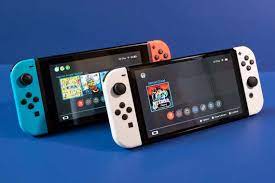Gaming Console Market: A Comprehensive Overview
The gaming console market has seen remarkable growth and transformation over the past few decades. From the early days of simple 8-bit games to today's advanced consoles featuring photorealistic graphics and immersive gameplay, the industry has consistently evolved. This article delves into the current state of the gaming console market, key market segments, the latest industry news, major companies, market drivers, and regional insights.
Market Overview
The global gaming console market is booming, driven by technological advancements, increased consumer spending on entertainment, and a growing gamer population. According to MRFR The Gaming Console market industry is projected to grow from USD 24.1 billion in 2022 to USD 33.8 billion by 2030, exhibiting a compound annual growth rate (CAGR) of 5.00% during the forecast period (2022 - 2030).
Request To Free Sample of This Strategic Report - https://www.marketresearchfuture.com/sample_request/10770
Key Market Segments
By Console Type
-
Home Consoles: Dominating the market, home consoles such as the Sony PlayStation, Microsoft Xbox, and Nintendo Switch offer high-performance gaming experiences with advanced graphics and large game libraries.
-
Handheld Consoles: Although not as prominent as home consoles, handheld devices like the Nintendo Switch Lite and Sony's PS Vita cater to gamers looking for portability.
-
Hybrid Consoles: The Nintendo Switch is a prime example, functioning both as a home console and a portable device, capturing a significant market share due to its versatility.
By End-User
-
Casual Gamers: This segment includes individuals who play games sporadically for entertainment and stress relief.
-
Hardcore Gamers: These are dedicated players who spend significant time and money on gaming, often participating in competitive gaming and esports.
-
Family Gamers: Families engaging in gaming activities together, often favoring consoles with multiplayer capabilities and family-friendly games.
By Distribution Channel
-
Online: Digital sales through online stores like PlayStation Store, Xbox Live, and Nintendo eShop are growing rapidly.
-
Offline: Physical stores and retail chains still hold a significant share, especially for console sales and accessories.
Industry Latest News
Next-Gen Console Releases
The release of next-gen consoles, such as the PlayStation 5 and Xbox Series X|S, has significantly impacted the market. These consoles offer enhanced performance, faster load times, and superior graphics, drawing considerable attention from both new buyers and upgraders.
Cloud Gaming
Cloud gaming services like Microsoft's Xbox Cloud Gaming (formerly Project xCloud) and Sony's PlayStation Now are reshaping the industry. These services allow gamers to stream games directly to their devices, eliminating the need for high-end hardware.
VR and AR Integration
Virtual and augmented reality are becoming integral to gaming. Companies like Sony with its PlayStation VR and Facebook with Oculus are leading the charge, offering immersive experiences that blur the line between gaming and reality.
Key Companies
- Sony Corporation (Japan)
- NVIDIA Corporation (US)
- Microsoft Corporation (US)
- Nintendo Co. Ltd. (Japan)
- Logitech Inc. (Switzerland)
- Valve Corporation (US)
- PlayJam (UK)
Market Drivers
Technological Advancements
Advancements in technology, including improved graphics, faster processors, and innovative gaming accessories, are driving market growth. Features like ray tracing and high frame rates are now standard in new consoles, enhancing the gaming experience.
Increasing Gamer Population
The number of gamers worldwide is increasing, driven by a growing youth population, increased internet penetration, and the rise of mobile gaming. This expanding audience is contributing to higher console sales and game purchases.
Esports and Competitive Gaming
The rise of esports has significantly boosted the gaming console market. Competitive gaming events, streaming platforms like Twitch, and professional leagues have turned gaming into a lucrative career, attracting millions of viewers and participants.
Content Diversity
The availability of diverse and engaging game titles is crucial. Exclusive games and franchises often drive console sales, with players buying consoles specifically to access certain games.
Ask for Customization - https://www.marketresearchfuture.com/ask_for_customize/10770
Regional Insights
North America
North America remains a dominant force in the gaming console market, driven by high disposable incomes, a strong gaming culture, and early adoption of new technologies. The U.S. is the largest market in this region.
Europe
Europe also holds a significant market share, with countries like the UK, Germany, and France being major contributors. The region is known for its robust esports scene and strong demand for both home and handheld consoles.
Asia-Pacific
The Asia-Pacific region is the fastest-growing market, with countries like Japan, China, and South Korea leading the charge. High mobile penetration, a large youth population, and a strong interest in gaming and esports fuel this growth.
Latin America and Middle East & Africa
These regions are witnessing steady growth, driven by improving economic conditions and increasing internet penetration. Brazil in Latin America and the UAE in the Middle East are notable markets.
Conclusion
The gaming console market is poised for continued growth, driven by technological advancements, a rising gamer population, and the evolving landscape of gaming entertainment. Key companies like Sony, Microsoft, and Nintendo remain at the forefront, continuously innovating to capture and expand their market share. As the industry evolves, new trends such as cloud gaming, VR, and esports will likely shape its future, offering exciting opportunities and experiences for gamers worldwide.



